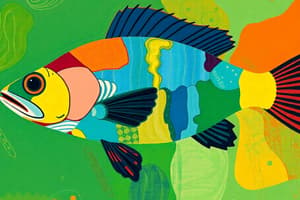Podcast
Questions and Answers
Which of the following features is NOT a characteristic of chordates?
Which of the following features is NOT a characteristic of chordates?
- Exoskeleton (correct)
- Dorsal hollow nerve cord
- Notochord
- Post-anal tail
What is a key evolutionary development that distinguishes vertebrates from other chordates?
What is a key evolutionary development that distinguishes vertebrates from other chordates?
- Complex life cycle
- Internal skeleton of vertebrae (correct)
- Presence of pharyngeal slits
- Post-anal tail reduction
How do pharyngeal slits function in different species of chordates?
How do pharyngeal slits function in different species of chordates?
- Only present in larval stages
- Primarily for excretion
- Used for feeding or respiration, depending on the species (correct)
- Only for respiration in adult forms
Which subphylum of chordates retains chordate characteristics throughout its life?
Which subphylum of chordates retains chordate characteristics throughout its life?
What role does the notochord play in chordate development?
What role does the notochord play in chordate development?
Which of the following describes the circulatory system in vertebrates?
Which of the following describes the circulatory system in vertebrates?
What significant evolutionary trend is observed in the development of vertebrates?
What significant evolutionary trend is observed in the development of vertebrates?
What is one of the adaptations that evolved in vertebrates to enhance their survival?
What is one of the adaptations that evolved in vertebrates to enhance their survival?
Flashcards
Chordates
Chordates
Animals characterized by a notochord, dorsal nerve cord, pharyngeal slits, and post-anal tail at some stage.
Notochord
Notochord
A flexible rod-like structure providing support and aiding locomotion in chordates.
Dorsal Hollow Nerve Cord
Dorsal Hollow Nerve Cord
A tube-like structure that develops into the central nervous system: brain and spinal cord.
Pharyngeal Slits
Pharyngeal Slits
Signup and view all the flashcards
Post-anal Tail
Post-anal Tail
Signup and view all the flashcards
Subphyla of Chordata
Subphyla of Chordata
Signup and view all the flashcards
Vertebrates
Vertebrates
Signup and view all the flashcards
Evolutionary Trends in Chordates
Evolutionary Trends in Chordates
Signup and view all the flashcards
Study Notes
General Characteristics
- Chordates are characterized by the presence of a notochord, a dorsal hollow nerve cord, pharyngeal slits or pouches, and a post-anal tail at some stage of their development.
- These features distinguish chordates from other animal phyla.
- The notochord is a flexible rod-like structure providing support and aiding locomotion.
- The dorsal hollow nerve cord develops into the central nervous system (brain and spinal cord).
- Pharyngeal slits or pouches connect the pharynx to the outside environment, functioning in feeding or respiration.
- The post-anal tail extends beyond the anus, often aiding locomotion in some species, but is frequently reduced or absent in adults.
Subphyla of Chordata
- Chordates are categorized into three subphyla: Urochordata (tunicates), Cephalochordata (lancelets), and Vertebrata (vertebrates).
- Urochordata are primarily marine, exhibiting a complex life cycle with a larval stage possessing chordate traits and an adult stage with a specialized tunic.
- Cephalochordata are also marine, retaining chordate features throughout their life cycle, representing an intermediate form.
- Vertebrata are a diverse group with an internal skeleton of vertebrae protecting the spinal cord. They include fishes, amphibians, reptiles, birds, and mammals.
Vertebrate Characteristics
- Vertebrates have an internal bony or cartilaginous skeleton.
- Vertebrae form a segmented column surrounding and protecting the spinal cord, providing support for muscles and enabling efficient movement.
- Vertebrates possess a closed circulatory system with a heart and blood vessels, enabling efficient oxygen and nutrient transport.
Evolutionary Trends
- Chordate evolution shows increasing complexity and specialization of organ systems.
- Key vertebrate evolutionary developments include a closed circulatory system, a more developed brain and central nervous system, and the development of jaws and limbs.
- Adaptations to varying environments contribute to the diverse range of vertebrate forms.
- Specialized sensory organs and complex behaviors have evolved to enhance survival and reproduction.
Importance of Chordates
- Chordates, especially vertebrates, are crucial components of global ecosystems.
- They are vital parts of food webs, affecting community structure and function.
- Humans rely on some chordate species for food and other resources.
- Maintaining biodiversity and ecosystem health depends on many chordate species.
Studying That Suits You
Use AI to generate personalized quizzes and flashcards to suit your learning preferences.




